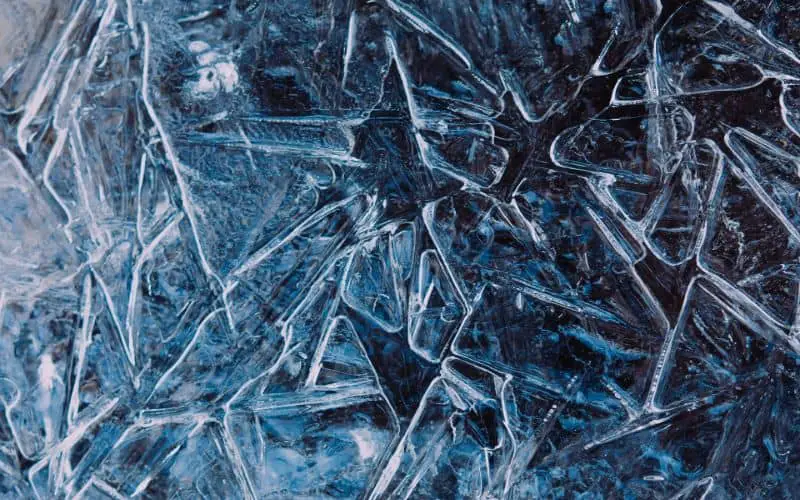Ice has long been seen as a symbol of coldness and stiffness, as well as of purity and cleanliness. In literature, it is often used to describe the frigid hearts of characters who are unemotional or uncompassionate.
In religion, ice is sometimes used as a metaphor for Heaven, due to its perceived perfection and lack of impurities. In alchemy, ice was seen as the embodiment of fixity, one of the four elemental properties along with fire, water, and earth.
To the ancient Greeks and Romans, ice was associated with the underworld, due to its ability to numb sensations and its association with coldness and death. In more recent times, ice has also been seen as a symbol of global warming and climate change, as melting glaciers have become one of the most visible signs of our changing world.
Whether it is used to describe an emotional state or a physical landscape, ice has always been a powerful symbol with a variety of meanings.

Quick Overview: Ice Symbolism
- Rigidity
- Frigidity
- Coldness
- Emotional Coldness
- Lack of Emotion
- Lack of Feeling
- Lack of Warmth
- Unfriendliness
- Indifference
- Reserved
- Aloof
- Calm
- Self-control
13 Ice Symbolisms
1. Rigidity

Ice is often seen as a symbol of rigidity, coldness, and inflexibility.
This is because ice is a solid, and solids are typically much more rigid than liquids or gases. Ice is also very cold, and this coldness can be seen as a symbol of heartlessness or lack of emotion.
Read More: Spear Symbolism
Finally, ice is very strong and difficult to break. This strength can be seen as a symbol of stubbornness or unwillingness to change.
In many ways, then, ice symbolizes some of the negative qualities that we associate with rigidity.
2. Frigidity

Throughout history, people have associated ice with coldness and rigidity.
The Roman author Ovid wrote that ice was the “sister of Chaos.” In the Middle Ages, people believed that ice was created when water vapor condensed in the air and then fell to the ground.
This belief led to the idea that ice was an attribute of Air, one of the four elements. Given its chilly reputation, it’s not surprising that ice has come to symbolize rigidity.
In literature, for example, women who are unfeeling or unresponsive are often described as being “as cold as ice.” And in popular culture, heartless characters are often said to have “a heart of ice.” In these ways and others, ice has come to symbolize all that is cold and unemotional.
3. Coldness

There are many reasons why ice is often used to symbolize coldness.
For one, ice is one of the few things that can exist in a liquid state at low temperatures. This makes it an ideal metaphor for anything that is cold or frozen.
Additionally, ice is often used to cool drinks, which makes it a natural choice for representing anything that is chilly or refreshing. Finally, the fact that ice can be both beautiful and dangerous makes it a perfect symbol of the duality of cold weather.
On the one hand, it can provide a stunning backdrop for winter activities. On the other hand, it can be deadly if someone falls through the ice into the frigid water. In short, ice is a versatile symbol that can connote both the positive and negative aspects of cold weather.
4. Emotional Coldness

Ice is often seen as a symbol of emotional coldness.
This is because ice is cold to the touch and has a hard, brittle texture. Ice is also very slippery, which can represent the difficulty of trying to connect with someone who is emotionally cold.
Furthermore, ice can be used to numb pain, and this can symbolize the way that people use emotional coldness as a way to protect themselves from hurt.
Finally, ice can melt when it is exposed to heat, which can represent the way that emotional coldness can thaw when someone experiences warmth and compassion.
5. Lack of Emotion

There are a few reasons why ice may symbolize a lack of emotion.
First, ice is cold, and emotions are often associated with warmth. For example, when we feel happy, we might say that we are “warm inside.” Conversely, when we feel sad or angry, we might say that we have a “cold heart.”
So the temperature of ice may suggest an absence of feeling. Additionally, ice is hard and brittle, while emotions are often seen as soft and pliable. We might say that someone who is feeling sad is “broken-hearted,” suggesting that emotions can be easily damaged.
And finally, ice is transparent, while emotions are often hidden from view. We might say that someone is “wearing their heart on their sleeve,” meaning that their emotions are readily apparent. But oftentimes, people keep their feelings hidden away, like a layer of ice over their hearts.
For all of these reasons, ice can be seen as a symbol of a lack of emotion.
6. Lack of Feeling

Ice has been used as a symbol for centuries. In literature, it is often used to represent the lack of feeling or emotion.
This is because ice is cold and hard, and it can be difficult to thaw. This symbolism can be seen in the works of many famous authors. For example, in F. Scott Fitzgerald’s novel “The Great Gatsby,” the character Daisy Buchanan is described as being “cold as ice.”
This is because she is unemotional and distant, and she often causes pain without even realizing it. In addition, in Shakespeare’s play “Macbeth,” the title character is referred to as “the insensible frozen man.”
This is because he has lost all sense of feeling, both physically and emotionally. As these examples demonstrate, ice is often used to symbolize the lack of feeling or emotion.
7. Lack of Warmth

Ice is a symbol of coldness and lack of warmth.
It is often used to describe someone who is unfriendly or unemotional. When we say that someone is “cold as ice,” we mean that they are very unapproachable and seem to lack any emotion.
Ice can also be used to describe a situation that is very unpleasant or has a lot of tension. For example, if we say that there is “the ice between two people,” we mean that they are not on good terms and there is a lot of tension between them.
In general, ice is seen as a negative symbol because it is associated with coldness, unfriendliness, and tension.
8. Unfriendliness

Ice can symbolize unfriendliness for a number of reasons.
First, it is cold and impersonal. It is difficult to form a bond with someone when you are constantly shivering and trying to keep warm.
Second, ice is slippery and dangerous. It can cause people to slip and fall, which can lead to injury. Finally, ice is hard and brittle. It can break easily, which can lead to feelings of isolation and loneliness.
When people are feeling cold, slippery, and broken, they are often less likely to be open and friendly towards others. As a result, ice can come to symbolize unfriendliness.
9. Indifference
Ice is often seen as a symbol of indifference because it is cold and hard.
It can be difficult to get close to someone who is cold and hard, and it can be difficult to feel empathy for someone who seems emotionless. Ice can also be seen as a barrier between people, preventing them from getting close to each other.
In literature, ice is often used as a metaphor for the distance between people. For example, in “The Girl with the White Flag,” by Tomoko Uriu, the protagonist is described as being “caught between the hunter and the prey, like an icicle.”
The image of an icicle suggests that she is cold and hard, but also that she is fragile and could easily break. Ice can also be seen as a symbol of death or decay because it is something that can kill people if they are not careful. In “The Call of Cthulhu,” by H.P. Lovecraft, the titular creature is described as being “cold as death, and almost conversational.”
This shows that Cthulhu is not only indifferent to human life but also that he represents a force that can destroy everything. Ice can be a powerful symbol, and it is often used to represent the darker aspects of human nature.
10. Reserved
Ice is a widely recognized symbol of coldness, reserve, and lack of emotion.
It is often seen as a barrier between people, something that prevents them from truly connecting with one another. In literature, ice is often used to represent the emotional distance between characters.
For example, in Jane Austen’s Pride and Prejudice, Mr. Darcy is initially described as being “as proud as a peacock” and seeming “nearly as unfeeling as one too.” However, over the course of the novel, he begins to thaw out and becomes more open with his feelings.
As a result, ice can be seen as a symbol of the barriers that prevent us from truly connecting with others, and how those barriers can eventually be broken down.
11. Aloof
Ice is often seen as a symbol of coldness and aloofness.
This is because ice is typically associated with freezing temperatures and unfriendly environments. When we see someone who is aloof, we often think of them as being unapproachable or even unfeeling. However, there is more to ice than just its cold reputation.
Ice can also be seen as a symbol of purity and cleanliness. This is because, in its natural state, ice is free of impurities and contaminants. It is also very reflective, which helps to create an illusion of perfection. For these reasons, ice can be seen as a symbol of both coldness and perfection. In many ways, it mirrors the personality of someone who is aloof.
They may seem unapproachable at first, but if you can get past their icy exterior, you may find that they are actually very pure and perfect people.
12. Calm
In literature, art, and popular culture, ice is often used as a symbol of calmness or serenity.
This is because ice is generally associated with cold temperatures, which are often seen as being calming and relaxing. For example, when it’s hot outside, people often enjoy cooling off with a cold drink or by taking a dip in a pool.
In the same way, when people are feeling stressed or anxious, they may try to “cool down” by taking a deep breath or spending time in nature. In these cases, ice serves as a reminder to stay calm and relaxed.
Additionally, the slow, methodical process of melting ice can also be soothing to watch. As the ice slowly changes form, it can help to lull someone into a state of relaxation. For all these reasons, ice has come to symbolize calmness and serenity.
13. Self-control
Ice is often seen as a symbol of self-control. This is because ice can be very hard to control.
It can be used to cool things down or to keep things from melting, but it can also be used to hurt people. Ice can also be slippery, making it difficult to walk on.
As a result, ice symbolizes the need for self-control. It reminds us that we need to be careful with our actions and words and that we should think before we act. Ice also symbolizes the need for patience. Just as it takes time for ice to melt, so too do changes in our lives take time.
Patience is required in order to see results. Lastly, ice symbolizes the ability to adapt. Just as ice can change from a solid to a liquid, so too can we adapt to new situations.
We can learn from our mistakes and grow as people. Ice is a reminder that we should always strive for self-improvement.
Spiritual Meanings of Ice

Ice has a long history of spiritual meanings and symbolism. In many cultures, ice is seen as a symbol of coldness, death, and freezing. It is also associated with purity, mystery, and the unknown.
For example, in ancient Greece, the goddess Nike was often depicted as being made of solid ice. In medieval Europe, ice was seen as a sign of the devil, and it was believed that it had the power to kill people.
In Native American mythology, ice is often associated with the spirit world and is believed to be a bridge between the physical and spiritual worlds. Today, ice still holds a variety of spiritual meanings for people around the world.
For some, it is a symbol of strength and resilience in the face of adversity. For others, it represents the power of nature and our connection to the natural world. No matter what your personal beliefs may be, there is no doubt that ice has a profound and unique place in our spiritual lives.
Ice Dream Meaning and Symbolism

One common interpretation of ice in a dream is that it represents emotion. This is because ice is often used to describe someone who is emotionally distant or cold.
If you dream that you are surrounded by ice, it may indicate that you feel isolated and alone. Alternatively, if you see someone made of ice in your dream, it could symbolize your feelings towards that person.
If you feel cold towards them, then the dream may simply be reflecting your current mood. However, if you feel particularly angry or resentful towards them, then the dream could be symbolic of those feelings.
Ice can also symbolize change or transition. This is because ice is often associated with water, which is itself a symbol of change and transformation.
If you have been through a major life change recently, such as a divorce or a move to a new city, then dreaming of ice could be a sign that you are still adjusting to your new circumstances. Alternatively, if you are about to embark on a major change, such as starting a new job or going away to college, dreaming of ice might represent your excitement or nerves about what lies ahead.
Finally, ice can sometimes be interpreted as a warning sign. This is because ice can be dangerous, especially if you do not take proper precautions when traveling on it or working with it. If you dream that you are walking on thin ice, it could be a sign that you are taking unnecessary risks in your life and need to be more cautious.
Alternatively, if you see someone else walking on thin ice in your dream, it could be symbolic of their current situation and suggest that they need to be careful in order to avoid disaster.
Conclusion
Ice has a variety of meanings and symbolism associated with it. It can represent emotion, change, and transition. It can also be interpreted as a warning sign. No matter what your personal beliefs may be, there is no doubt that ice has a profound and unique place in our spiritual lives.

